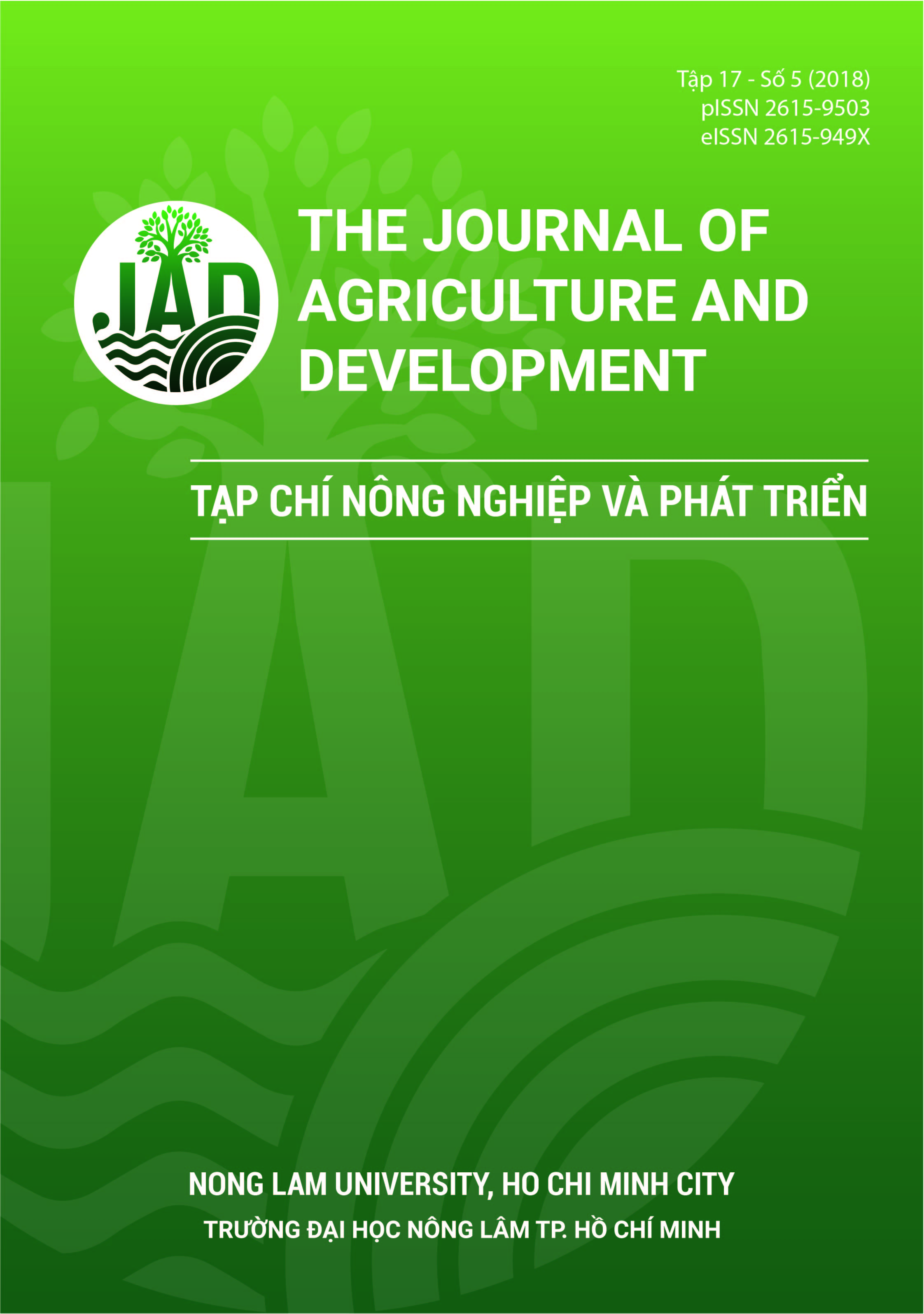Separation of active constituents in some medicinal plants by thin layer chromatography
Main Article Content
Abstract
Separation and identification of the active pharmacological compounds from some medicinal plants (Citrus aurantifolia, Rhodomyrtus tomentosa, Camellia sinensis) by Thin Layer Chromatography (TLC) showed the yields of crude extracts ob-tained from Citrus aurantifolia, Rhodomyrtus tomentosa and Camellia sinensis leaves at 1.5%, 5.62% and 10.4% respectively. Toluene: ethyl acetate (93:7) (v:v) solvent was suitable for the separation of active compounds in crude extract of Citrus auran-tifolia, Rhodomyrtus tomentosa leaves while chloroform: ethy-lacetate: formic acid (5:4:1) (v:v:v) solvent was suitable for the extraction of active compounds in crude extract from Camelliasinensis leaves. Furthermore, the results showed that the num-ber of compounds in extract from Citrus aurantifolia were like lyaffected by the vacuum evaporator effects. The TLC fingerprints of all three medicinal plants had the same visual ability when the fingerprint detected by UV (λ= 254 nm) and the reagent containing 0.1 g vanillin in 28 mL of methanol: 1 mL of sulfuric acid. In brief, the three active compounds including citral (Cit-rus aurantifolia), rhdomyrtone (Rhodomyrtus tomentosa) and catechin hydrate (Camellia sinensis) contained in the extract of 3 medicinal herbs had the limited detection (LOD) at 195 ng/spot, 321.5 ng/spot and 625 ng/spot, respectively.
Article Details
References
Asadhawut, H. (2010). Chemical Constituents from Rhodomyrtus tomentosa (Aiton) Hassk and antibacterial activity (Unpublished doctoral dissertation). Prince of Songkla University, Hat Yai, Thailand.
Ashray, G. (2012). Extraction, purification, identification and estimation of catechins from Camellia sinensis (Unpublished bachelor’s thesis). Institute of Himalayan Bioresource Technology (IHBT), Palampur, India.
Auemphon, M., Shiv, S., Usa, C., & Voravuthikunchai, S. P. (2015). Effects of Rhodomyrtus tomentosa leaf extract on staphylococcal adhesion and invasion in bovine udder epidermal tissue model. Nutrients 7(10), 8503-8517. https://doi.org/10.3390/nu7105410
Chao, S., Kaikuo, S., Xiaorong, Z., Yi, S., Yue, S., Yifei, C., Zhenyu, J., Huihui, S., Zheng, S., & Xiaodong, X. (2016). Antimicrobial activity and possible mechanism of action of citral against Cronobacter sakazakii. PloS One 11(7), e0159006. https://doi.org/10.1371/journal.pone.0159006
Charles, L., & Kayanja, I. B. F. (2012). In Vitro antimicrobial activity of crude extracts of Erythrina abyssinica and Capsicum annum in poultry diseases control in the South Western Agro-Ecological zone of Uganda. In Perez-Marin, C. C. (Ed.). A Bird’s-Eye View of Veterinary Medicine (ed., 597-614). London, United Kingdom: InTech.
Dinesh, K., Ashu, G., & Upendra, S. (2015). Determination of theanine and catechin in Camellia sinensis (Kangra tea) leaves by HPTLC and NMR techniques. Food Analytical Methods 9(6), 1666-1674. https://doi.org/10.1007/s12161-015-0343-z
Do, L. T. (2004). Medicinal plants and herbs in Vietnam. Ha Noi, Vietnam: Medical Publishing House.
Eloff, J. N. (1998). Which extractant should be used for the screening and isolation of antimicrobial components from plants? Journal of Ethnopharmacology 60(1), 1-8. https://doi.org/10.1016/S0378-8741(97)00123-2
Eloff, J. N., Ntloedibe, D. T., & van Brummelen, R. (2011). A simplified but effective method for the quality control of medicinal plants by planar chromatography. African Journal of Traditional, Complementary and Alternative Medicines 8(S), 1-12. https://doi.org/10.4314/ajtcam.v8i5SS.
Grace, O. O. (1989). Evaluation of the antimicrobial activity of citral. Letters in Applied Microbiology 9(3), 105-108. https://doi.org/10.1111/j.1472-765X.1989.tb00301.x
Hiranrat, A. (2010). Chemical constituent from Rhodomyrtus tomentosa (Aiton) Hassk. and antibacterial activity (Doctoral Thesis). Prince of Songkla University, Hat Yai, Thailand.
Lanlan, B., Shiaki, T., Tasuke, A., Hiroshi, Y., Kumiko, I., Hiroyuki, M., & Emiko, I. (2016). Antimicrobial activity of tea catechin against canine oral bacteria and the functional mechanisms. The Journal of Veterinary Medical Science 78(9), 1439-1445. https://doi.org/10.1292/jvms.16-0198
Maria, C. A. L., André, P. B. B., Janiere, P. S., Felipe, Q. S. G., & Edeltrudes, O. L. (2014). Evaluation of antifungal activity and mechanism of action of citral against Candida albicans. Evidence-Based Complementary and Alternative Medicine 2014, 1-9. https://doi.org/10.1155/2014/378280
Matthew, J. C., Aishwarya, I., Baxter, B., & Ian, E. C. (2017). Developing new antimicrobial therapies: are synergistic combinations of plant extracts/compounds with conventional antibiotics the solution?. Pharmacognosy Reviews 11(22), 57-72. https://doi.org/10.4103/phrev.phrev_21_17
Mordmuang, A., Shankar, S., Chethanond, U., & Voravuthikunchai, S. P. (2015). Effects of Rhodomyrtus tomentosa leaf extract on staphylococcal adhesion and invasion in bovine udder epidermal tissue model. Nutrients 7(10), 8503-8517. https://doi.org/10.3390/nu7105410
Sibanda, T., & Okoh, A. I. (2007). The challenges of overcoming antibiotic resistance: Plant extracts as potential sources of antimicrobial and resistance modifying agents. African Journal of Biotechnology 6(25), 28862896.
Sukanlaya, L., Peter, W. T., & Voravuthikunchai S. P. (2013). Antibacterial mechanisms of rhodomyrtone against important hospital-acquired antibioticresistant pathogenic bacteria. Journal of Medical Microbiology 62(1), 78-85. https://doi.org/10.1099/jmm.0.049205-0
Surasak, L., Erik, N. T., Thijs, R. H. M. K., Sjouke, P., Hiranrat, A., Mahabusarakam, W., Voravuthikunchai, S. P., Jan, M. V. D., & Kayser, O. (2009). Rhodomyrtone: a new candidate as natural antibacterial drug from Rhodomyrtus tomentosa. Phytomedicine 16(6-7), 645-651. https://doi.org/10.1016/j.phymed.2009.01.010
Surasak, L., Oliver, K., & Voravuthikunchai, S. P. (2012). Antibacterial activity of Rhodomyrtus tomentosa (Aiton) Hassk. leaf extract against clinical isolates of Streptococcus pyogenes. Evidence-Based Complementary and Alternative Medicine 2012, 1-6. https://doi.org/10.1155/2012/697183
VPC (Vietnam Pharmacopoeia Center). (2009). Vietnamese pharmacopoeia IV. Ha Noi, Vietnam: Ministry of Health.
Wagner, H., & Bladt, S. (1996). Plant drug analysis; A thin layer chromatography atlas (2nd ed.). Berlin, Germany: Springer.
Wanda, C. R. (2014). The antimicrobial possibilities of green tea. Frontiers in Microbiology 5, 434. https://doi.org/10.3389/fmicb.2014.00434
Yukiko, H. K., Akiko, Y., Miho, S., Tsutomu, O., Yuji, M., Minoru, H., Kazuo, K., & Yoshiko, S. K. (2005). Antibacterial action on pathogenic bacterial spore by green tea catechins. Journal of the Science of Food and Agriculture 85(14), 2354-2361. https://doi.org/10.1002/jsfa.2259








